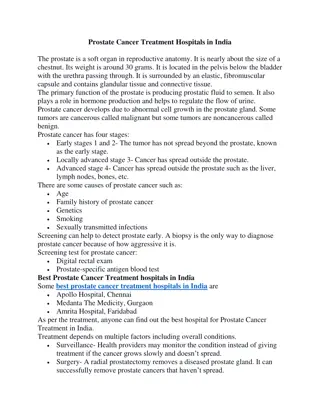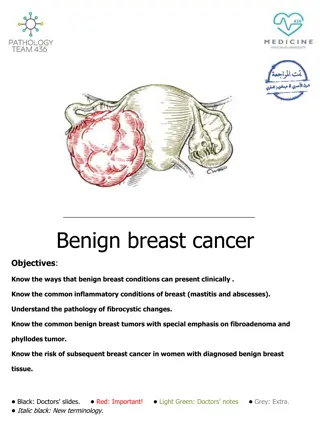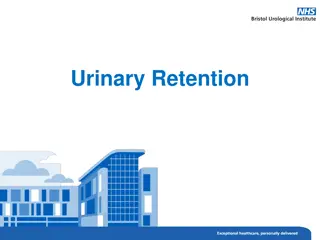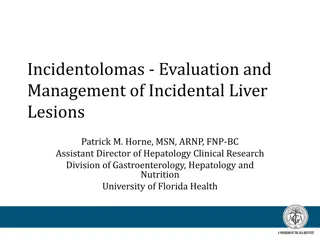
Benign Prostatic Hyperplasia: Symptoms, Diagnosis, and Treatment
Learn about the differential diagnosis, history-taking, clinical examination, laboratory tests, and treatment modalities for a 60-year-old man presenting with lower urinary tract symptoms suggestive of Benign Prostatic Hyperplasia (BPH). Explore the etio-pathophysiological factors, prevalence, and management strategies associated with this common male health issue.
Download Presentation

Please find below an Image/Link to download the presentation.
The content on the website is provided AS IS for your information and personal use only. It may not be sold, licensed, or shared on other websites without obtaining consent from the author. If you encounter any issues during the download, it is possible that the publisher has removed the file from their server.
You are allowed to download the files provided on this website for personal or commercial use, subject to the condition that they are used lawfully. All files are the property of their respective owners.
The content on the website is provided AS IS for your information and personal use only. It may not be sold, licensed, or shared on other websites without obtaining consent from the author.
E N D
Presentation Transcript
Approach to Benign Prostatic Approach to Benign Prostatic Hyperplasia Hyperplasia A common Adult Male Problem
Case Scenario: A 60-year-old gentleman who is retired from the military services. He is presented to the clinic with the history of hesitancy, urgency and increased urination for the past few months. The symptoms have been increased past few weeks. He says that occasionally, he gets wet his underwear if he could not reach a toilet immediately. He is not known to have any problem in past. Q1: What are the differential diagnosis of lower urinary tract symptoms? Q2: What are points to be discussed in taking history? Q3: What are the clinical examination to be performed for this patient? Q4: What are the laboratory tests to be performed for this patient? Q5: What are the treatment modalities for this patient?
Objectives 1. Discuss the differential diagnosis of lower urinary tract symptoms (LUTS). 2. What are the etio-pathophysiological factors and prevalence of BPH. 3. Identify important points to be included in taking history of a suspected case of BPH. 4. Discuss the clinical examination to be performed in a case of suspected BPH. 5. Discuss the laboratory tests to be performed in a case of suspected BPH. 6. Recognize the treatment modalities of a suspected case of BPH.
Prevalence A prostate volume > 30 mL and a moderate or high American Urological Association Symptom Score taken in consideration of BPH prevalence. In men aged 55 to 74 without prostate cancer is 19%. Based on autopsy studies, the prevalence of BPH increases from 8% in men aged 31 to 40 years to 40 to 50% in men aged 51 to 60 years and to > 80% in men > 80 years.
Etio-Pathophysiology The etiology is unknown but probably involves hormonal changes associated with aging. Multiple fibroadenomatous nodules develop in the periurethral region of the prostate, probably originating within the periurethral glands The lumen of the prostatic urethra narrows and lengthens, urine outflow is progressively obstructed. Therefore, etio-pathological changes are multi-factorial; smooth muscle hyperplasia, Prostatic enlargement, bladder dysfunction, input from the central nervous system
Etio-Pathophysiology Increased pressure associated with micturition and bladder distention can progress to hypertrophy of the bladder detrusor, trabeculation, cellular formation, and diverticula. Incomplete bladder emptying causes stasis and predisposes to calculus formation and infection. Prolonged urinary tract obstruction, even if incomplete, can cause hydronephrosis and compromise renal function.
Symptoms and Signs Lower urinary tract symptoms Urinary Retention Symptoms Score Digital Rectal Examination
Symptoms and Signs Lower urinary tract symptoms Often progressive, known collectively as lower urinary tract symptoms (LUTS): Presents with both storage symptoms:- - (frequency, urgency, nocturia, and incontinence) and voiding symptoms:- - (weak stream, dribbling, dysuria, straining).
Differential diagnosis for luts Overactive bladder Prostatitis UTI Neurogenic bladder Urethral Stricture Bladder Ca Prostate Ca
Symptoms and Signs Lower urinary tract symptoms Frequency, urgency, and nocturia are due to: incomplete emptying and rapid refilling of the bladder. Decreased size and force of the urinary stream cause hesitancy and intermittency. Pain and dysuria are usually not present. Sensations of incomplete emptying, terminal dribbling, overflow incontinence, or complete urinary retention may ensue. Straining to void can cause congestion of superficial veins of the prostatic urethra and trigone, which may rupture and cause hematuria. Straining also may acutely cause vasovagal syncope and, over the long term, may cause dilation of hemorrhoidal veins or inguinal hernias.
Symptoms and Signs Urinary retention Some patients present with sudden, complete urinary retention, with marked abdominal discomfort and bladder distention. Retention may be precipitated by any of the following: Prolonged attempts to postpone voiding Immobilization Exposure to cold Use of anesthetics, anticholinergics, sympathomimetics, opioids, or alcohol Symptom scores
American Urological Association Symptom Index To assess severity of benign prostatic hyperplasia (BPH): A score of 7 or less indicates mild BPH; A score of 8 to 19 indicates moderate BPH; A score of 20 to 35 indicates severe BPH.
Digital rectal examination Assess anal sphincter tone, bladder palpation and external meatus Prostate usually is enlarged, nontender and rubbery consistency, In many cases has lost the median furrow. Prostate size as detected with digital rectal examination may be misleading; an apparently small prostate may cause obstruction. If bladder distended, the urinary bladder may be palpable or percussible during abdominal examination. Firm or hard areas in the prostate may indicate prostate cancer.
Diagnosis Diagnosis Typical History Digital rectal examination Urinalysis and urine culture to exclude UTI Prostate-specific antigen level Bladder ultrasonography Uroflowmetry
Diagnosis Diagnosis Prostate-specific antigen (PSA) levels Interpreting prostate-specific antigen (PSA) levels can be complex. It is moderately elevated in 30 to 50% of patients with BPH, depending on prostate size and degree of obstruction. It is elevated in 25 to 92% of patients with prostate cancer, depending on the tumor volume.
Diagnosis Diagnosis Prostate-specific antigen (PSA) levels In patients without cancer, serum PSA levels: >1.5 ng/mL (1.5 mcg/L) usually indicate a prostate volume 30 mL. > 4 ng/mL (4 mcg/L), further discussion/shared decision-making regarding other tests or biopsy is recommended. For men aged < 50 or those at high risk of prostate cancer, lower cutoff (PSA > 2.5 ng/mL [2.5 mcg/L]) may be used.
Diagnosis Diagnosis Other testing Per-abdimen Ultrasonography Transrectal ultrasonography is an accurate way to measure prostate volume. Transrectal biopsy is usually done with ultrasound guidance and is usually only indicated if there is suspicion of prostate cancer. Clinical judgment must be used to evaluate the need for further testing.
Diagnosis Diagnosis Other testing Alternatively, multiparametric MRI, which is more sensitive than transrectal biopsy. Restricting biopsies to areas found to be suspect on multiparametric MRI may reduce the number of prostate biopsies and diagnoses of clinically insignificant prostate cancers. Cystoscopy may help determine the optimal surgical approach and to rule out other obstructive causes such as strictures.
Treatment: Treatment: A. General Instruction: Self-directed behavioral management program A.Pharmacological: Alpha-adrenergic blockers B.Surgical: Transurethral resection
A. General A. General Self-directed behavioral management program Limitation of fluids, Bladder training focused on timed and complete voiding, Treatment of constipation, which may help patients to regulate urinary symptoms. fluid avoidance after dinner, limitation of caffeinated beverages, and avoidance of diuretics Review of the patient's medication list will help to identify opportunities to modify or avoid medications that may impact symptoms of BPH.
Specific Treatment Specific Treatment A. Pharmacological 1. Alpha-adrenergic blockers: Terazosin, Doxazosin, Tamsulosin, Alfuzosin, Silodosin, 2. 5 alpha-reductase inhibitors Finasteride, Dutasteride, 1. Phosphodiesterase type 5 inhibitor: Tadalafil, B. Surgical Transurethral resection of the prostate or others
Pharmacological Treatment Pharmacological Treatment Alpha-adrenergic blockers: For patients with mild to moderate obstructive symptoms, decreases voiding problems 5 alpha-reductase inhibitors: Reduces prostate size, decreasing voiding problems over months, especially in patients with larger (> 30 mL or even >40mL) glands. A combination of both classes of drugs is superior to monotherapy. Phosphodiesterase type 5 inhibitor: For men with concomitant erectile dysfunction, daily tadalafil may help relieve both conditions.
Surgical Surgical Treatment Treatment Indications: 1. No response to drug therapy 2. Develop complications: 1. Recurrent UTI, Renal stones, 2. Severe bladder dysfunction, 3. Upper UTI .
Surgical Surgical Treatment Treatment Transurethral resection of the prostate (TURP) is the standard. Erectile function and continence are usually retained, although about 5 to 10% of patients experience some postsurgical problems, most commonly retrograde ejaculation. The incidence of erectile dysfunction after TURP is between 1 and 35%, About 10% of men undergoing TURP need the procedure repeated within 10 years because the prostate continues to grow.
Surgical Surgical Treatment Treatment Other procedures Alternatives to TURP include Microwave thermotherapy, Electrovaporization, Various laser techniques, High-intensity focused ultrasonography, Transurethral needle ablation, Radiofrequency vaporization, pressurized heated water injection therapy, urethral lift, steam injection therapy, and intraurethral stents.
Treatment Treatment Urinary retention: Significant urinary retention requires immediate decompression. Passage of a standard urinary catheter is first attempted;
complications of long standing BPH complications of long standing BPH 1. Acute urinary retention 2. Recurrent UTI, 3. Renal stones, 4. Severe bladder dysfunction, 5. Upper UTI .
Urgent Referral Urgent Referral IndicationS to to Urology Urology IndicationS
1. Microscopic or macroscopic hematuria 2. Neurological disease (such as long-standing diabetes): may suggest neurogenic bladder 3. H/O prior urological surgeries and urethral stricture 4. History of recurrent infection 5. Palpable bladder 4. Renal impairment due to lower urinary tract dysfunction 5. Abnormal digital rectal exam suggesting prostate cancer 6.Abnormal PSA levels.
Summary of the Management Summary of the Management Plan Plan






















